Between 2025 and 2035, the vibrating gravity feeder market is projected to increase from USD 437.0 million to USD 718.7 million, growing at a CAGR of 5.1%. The vibrating gravity feeder industry stands at the threshold of a decade-long expansion trajectory that promises to reshape material handling technology and industrial automation systems. The market's journey from USD 437 million in 2025 to USD 718.7 million by 2035 represents substantial growth, demonstrating the accelerating adoption of advanced feeding systems and precision material handling technology across food processing, mining operations, construction, pharmaceutical, chemical processing, and plastics manufacturing sectors.
The first half of the decade (2025-2030) will witness the market climbing from USD 437.0 million to approximately USD 589 million, adding USD 152.0 million in value, which constitutes 54% of the total forecast growth period. This phase will be characterized by the rapid adoption of multi-hopper gravimetric feeding systems, driven by increasing industrial automation requirements and the growing demand for precise material handling worldwide. Advanced vibrating control capabilities and automated dosing features will become standard expectations rather than premium options.
The latter half (2030-2035) will witness sustained growth from USD 589.0 million to USD 718.7 million, representing an addition of USD 129.7 million or 46% of the decade's expansion. This period will be defined by mass market penetration of integrated feeding systems, compatibility with comprehensive industrial control platforms, and seamless integration with existing manufacturing infrastructure. The market trajectory signals fundamental shifts in how industrial facilities approach material handling and dosing precision, with participants positioned to benefit from sustained demand across multiple feeder types and application segments.
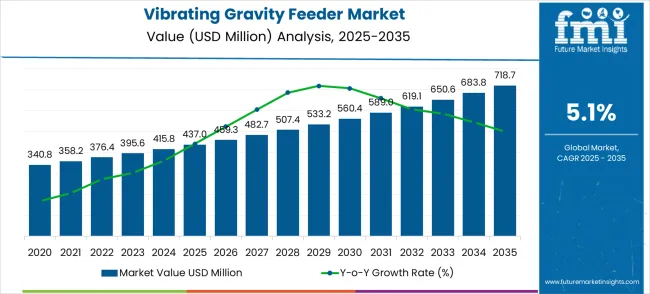
The Vibrating Gravity Feeder market demonstrates distinct growth phases with varying market characteristics and competitive dynamics. Between 2025 and 2030, the market progresses through its technology adoption phase, expanding from USD 437.0 million to USD 589.0 million with steady annual increments averaging 5.1% growth. This period showcases the transition from basic feeding systems to advanced multi-hopper configurations with enhanced precision capabilities and integrated control systems becoming mainstream features.
The 2025-2030 phase adds USD 152.0 million to market value, representing 54% of total decade expansion. Market maturation factors include standardization of industrial automation protocols, declining component costs for vibrating control systems, and increasing manufacturing awareness of precision feeding benefits reaching 92-96% accuracy in material dosing applications. Competitive landscape evolution during this period features established material handling companies like Coperion, K-Tron, and FLSmidth expanding their vibrating feeder portfolios while specialized manufacturers focus on advanced control algorithms and enhanced precision capabilities.
From 2030 to 2035, market dynamics shift toward comprehensive industrial integration and multi-facility deployment, with growth continuing from USD 589.0 million to USD 718.7 million, representing an addition of USD 129.7 million, or 22% of total expansion. This phase transition centers on integrated feeding networks, compatibility with industrial IoT systems, and deployment across diverse manufacturing scenarios, becoming standard rather than specialized applications. The competitive environment matures, with a focus shifting from basic feeding capabilities to comprehensive material handling optimization systems and integration with production monitoring platforms.
| Metric | Value |
|---|---|
| Market Value (2025) | USD 437.0 million |
| Market Forecast (2035) | USD 718.7 million |
| Growth Rate | 5.1% CAGR |
| Leading Technology | Multi-Hopper Gravimetric Feeder Type |
| Primary Application | Food & Beverages Segment |
The market demonstrates strong fundamentals with multi-hopper gravimetric systems capturing a dominant share through advanced precision feeding and material handling optimization capabilities. Food & beverages applications drive primary demand, supported by increasing food processing automation and material handling technology requirements. Geographic expansion remains concentrated in developed markets with established industrial infrastructure, while emerging economies show accelerating adoption rates driven by manufacturing modernization and rising industrial automation standards.
Market expansion rests on three fundamental shifts driving adoption across industrial and manufacturing sectors. 1. Industrial automation demand creates compelling operational advantages through vibrating gravity feeders that provide immediate material handling precision without process complexity, enabling facilities to achieve dosing accuracy while maintaining production efficiency and reducing operational costs. 2. Manufacturing modernization accelerates as production facilities worldwide seek advanced feeding systems that complement traditional material handling, enabling precise material dosing and quality control applications that align with industrial standards and automation regulations. 3. Production infrastructure enhancement drives adoption from food processing facilities and industrial manufacturers requiring effective feeding solutions that minimize material waste while maintaining operational productivity during material handling and dosing operations.
However, growth faces headwinds from initial equipment investment challenges that vary across industries regarding the deployment of advanced feeding systems and integration costs, which may limit adoption in cost-sensitive manufacturing environments. Technical limitations also persist regarding system maintenance and environmental conditions that may reduce effectiveness in extreme temperature or vibration environments, which affect feeding accuracy and system reliability.
The vibrating gravity feeder market represents a specialized yet strategically important industrial automation opportunity driven by manufacturing modernization, precision material handling requirements, and the global shift toward automated production systems. As manufacturers worldwide seek to achieve 94-98% dosing accuracy, reduce material waste, and integrate advanced feeding systems with comprehensive automation platforms, vibrating gravity feeders are transitioning from basic material handling equipment to intelligent, precision-controlled production components.
The convergence of Industry 4.0 adoption, food processing automation, and manufacturing infrastructure enhancement creates sustained demand drivers across multiple industrial sectors. Geographic expansion opportunities are particularly pronounced in Asia-Pacific markets, where China (6.9% market share) and India (6.4%) lead through aggressive manufacturing modernization programs and industrial automation infrastructure development.
Technology differentiation through multi-hopper configurations, advanced control algorithms, and IoT integration enables premium positioning, while application diversification across the dominant food & beverages segment (28.4% market share) and expanding mining & metallurgy (24.1%), construction (18.3%), and pharmaceutical applications creates multiple revenue streams. The market's growth from USD 437.0 million in 2025 to USD 718.7 million by 2035 reflects fundamental shifts in manufacturing precision requirements and automated material handling adoption across diverse industrial applications.
Strengthening the dominant multi-hopper gravimetric feeder segment (57.3% market share) through advanced engineering, simultaneous multi-material handling capabilities, and integrated control systems enabling 2-8 different materials with 94-98% accuracy. This pathway focuses on enhanced precision algorithms, automated material blending, reduced production complexity, and seamless integration with existing manufacturing equipment. Market leadership consolidation through superior engineering, comprehensive automation compatibility, and specialized configurations enables premium pricing while defending competitive advantages against single-hopper alternatives and expanding market penetration across diverse industrial applications.
Rapid industrial development across China (6.9% market share) and India (6.4%) creates substantial expansion opportunities through local manufacturing partnerships, government industrial automation programs, and comprehensive supply chain development. Growing manufacturing infrastructure, automation technology adoption, and precision feeding requirements create sustained demand for advanced systems. Localization strategies reduce import costs, enable faster deployment, and position companies advantageously for government procurement programs while accessing growing domestic markets requiring specialized feeding solutions for food processing and industrial manufacturing applications.
Expansion within the dominant food & beverages segment (28.4% market share) through specialized hygiene-compliant systems, precision ingredient handling, recipe consistency applications, and food safety monitoring integration. This pathway addresses stringent food processing requirements, contamination control, automated quality assurance, and compliance with evolving food safety regulations. Premium positioning reflects food-grade engineering, enhanced hygiene features, and comprehensive traceability capabilities that support modern food processing automation while enabling integration with comprehensive food safety management systems and quality control platforms.
Development of intelligent feeding systems featuring IoT connectivity, predictive maintenance capabilities, real-time production monitoring, and integration with comprehensive industrial automation platforms. This pathway encompasses remote diagnostics, automated performance optimization, production data analytics, and seamless compatibility with Industry 4.0 ecosystems. Technology differentiation through advanced control algorithms, cloud connectivity, and predictive analytics enables service-based revenue models and ongoing customer relationships while supporting manufacturers' transition toward smart factory operations and comprehensive production optimization.
Expansion beyond food processing into specialized mining & metallurgy (24.1% share) and construction applications (18.3%) requiring ruggedized systems, high-capacity operations, and environmental durability for demanding industrial conditions. This pathway addresses ore processing, mineral extraction, aggregate handling, and construction material manufacturing with specialized engineering for harsh environments. Premium pricing reflects industrial-grade construction, enhanced durability, and specialized capabilities necessary for challenging operational conditions while creating opportunities for long-term maintenance contracts and specialized service support.
Specialized expansion into pharmaceutical (12.2% share) and chemical processing applications (9.7%) requiring ultra-precise dosing, contamination prevention, and compliance with stringent regulatory standards. This pathway encompasses drug manufacturing precision, powder handling accuracy, specialty chemical processing, and comprehensive documentation for regulatory compliance. Ultra-premium positioning reflects scientific-grade accuracy, regulatory compliance capabilities, and specialized contamination prevention features necessary for pharmaceutical and chemical applications, while enabling comprehensive validation services and regulatory consulting support.
Transformation from equipment sales to service-centric solutions, including maintenance contracts, calibration services, operator training programs, system optimization consulting, and equipment-as-a-service models addressing high capital investment barriers. This pathway leverages technical complexity and precision requirements to create recurring revenue streams while reducing customer operational burden and maintenance risks. Comprehensive service offerings, including predictive maintenance, performance optimization, and technical support, enable higher customer lifetime values and market differentiation through operational excellence and ongoing partnership relationships across diverse industrial applications.
Primary Classification: The market segments by feeder type into Single Hopper Gravimetric Feeder and Multi-Hopper Gravimetric Feeder categories, representing the evolution from basic feeding systems to advanced multi-point material handling solutions for comprehensive production optimization.
Secondary Classification: Application segmentation divides the market into Food & Beverages, Mining & Metallurgy, Construction, Pharmaceutical, Chemicals, Plastics, and Others sectors, reflecting distinct requirements for material handling precision, capacity needs, and operational complexity.
Regional Classification: Geographic distribution covers North America, Europe, Asia Pacific, Latin America, and the Middle East & Africa, with developed markets leading adoption while emerging economies show accelerating growth patterns driven by manufacturing modernization programs.
The segmentation structure reveals technology progression from single-point feeding systems toward integrated multi-hopper configurations with enhanced precision and automation capabilities, while application diversity spans from food processing operations to specialized industrial manufacturing requiring precise material handling solutions.
Market Position: Multi-Hopper Gravimetric Feeder systems command the leading position in the Vibrating Gravity Feeder market with approximately 57.3% market share through advanced feeding capabilities, including multi-point material handling, precision dosing control, and system integration that enable manufacturers to achieve optimal material distribution across diverse industrial production environments.
Value Drivers: The segment benefits from industrial preference for comprehensive feeding systems that provide simultaneous multi-material handling, reduced production complexity, and manufacturing efficiency optimization without requiring multiple single-point installations. Advanced configuration features enable automated material blending, quality consistency, and integration with existing production equipment where precision and multi-material capability represent critical operational requirements.
Competitive Advantages: Multi-Hopper systems differentiate through simultaneous material handling capability, advanced control algorithms, and integration with industrial automation platforms that enhance operational effectiveness while maintaining optimal material precision suitable for diverse manufacturing and processing applications.
Key market characteristics:
Single Hopper Gravimetric Feeder systems maintain a significant 42.7% market share in the Vibrating Gravity Feeder market through specialized single-material applications and cost-effective feeding solutions. These systems appeal to manufacturers requiring focused material handling for specific production processes with precise dosing control features. Market growth is driven by small-scale manufacturing operations emphasizing reliable feeding solutions and operational efficiency through optimized single-material handling systems.
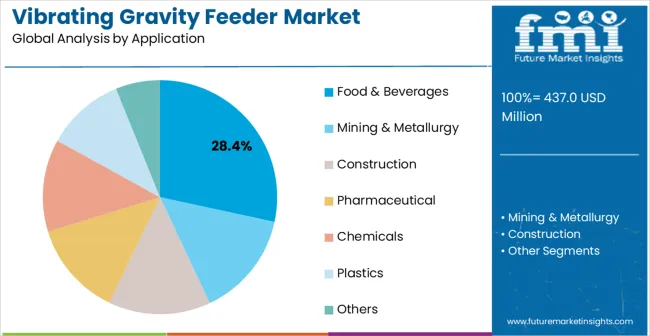
Market Context: Food & beverages applications dominate the Vibrating Gravity Feeder market with approximately 28.4% market share due to widespread adoption of precision feeding systems and increasing focus on food processing automation, ingredient handling management, and quality control applications that enhance product consistency while maintaining food safety standards.
Appeal Factors: Food & beverages manufacturers prioritize system hygiene, precision dosing, and integration with existing food processing infrastructure that enables coordinated ingredient handling across multiple production lines. The segment benefits from substantial food industry investment and modernization programs that emphasize the acquisition of feeding systems for quality control and production efficiency applications.
Growth Drivers: Food safety regulations incorporate precision feeding as standard equipment for ingredient handling and recipe consistency applications. In contrast, food processing facility upgrades increase demand for advanced feeding capabilities that comply with food safety standards and minimize contamination risks.
Market Challenges: Varying food safety standards and processing technology differences may limit system standardization across different food production facilities or operational scenarios.
Application dynamics include:
Mining & Metallurgy applications capture approximately 24.1% market share through specialized material handling requirements in ore processing, mineral extraction, and metallurgical operations. These facilities demand ruggedized systems capable of operating in demanding environments while providing effective material dosing and handling capabilities.
Construction applications account for approximately 18.3% market share, focusing on material handling requirements for concrete production, aggregate processing, and construction material manufacturing facilities.
Pharmaceutical applications represent approximately 12.2% market share through specialized precision requirements in drug manufacturing, powder handling, and pharmaceutical production processes requiring stringent quality control.
Chemical industry applications hold approximately 9.7% market share, including chemical processing, powder handling, and specialty chemical manufacturing facilities requiring precise material dosing capabilities.
Plastic applications account for approximately 7.3% market share through specialized material handling in plastic production, polymer processing, and resin manufacturing operations.
Other industrial applications represent approximately 6.0% market share, including general manufacturing, powder processing, and specialized industrial facilities requiring material handling capabilities for production optimization.
Growth Accelerators: Industrial automation adoption drives primary demand as vibrating gravity feeders provide precision material handling capabilities that enable facilities to achieve dosing accuracy without excessive manual oversight, supporting manufacturing operations and production efficiency missions that require precise material handling applications. Manufacturing infrastructure demand accelerates market expansion as production facilities seek effective feeding systems that minimize material waste while maintaining operational effectiveness during material handling and dosing scenarios. Automation technology spending increases worldwide, creating sustained demand for feeding systems that complement traditional material handling and provide operational flexibility in complex industrial environments.
Growth Inhibitors: Initial equipment investment challenges vary across industries regarding the deployment of advanced feeding systems and integration costs, which may limit operational flexibility and market penetration in regions with limited automation budgets or cost-sensitive manufacturing operations. Technical performance limitations persist regarding system maintenance and environmental conditions that may reduce effectiveness in extreme temperature, humidity, or vibration environments, affecting feeding accuracy and system reliability. Market fragmentation across multiple industrial specifications and manufacturing standards creates compatibility concerns between different system manufacturers and existing production infrastructure.
Market Evolution Patterns: Adoption accelerates in the food processing and manufacturing sectors, where precision requirements justify system costs. This trend is shifting from geographic concentration in developed markets to mainstream adoption in emerging economies, driven by the development of manufacturing modernization and industrial automation. Technology development focuses on enhanced control algorithms, improved vibration optimization, and integration with industrial IoT systems that optimize material handling and operational effectiveness. The market could face disruption if alternative feeding technologies or automation regulations significantly limit the deployment of vibrating feeders in industrial or manufacturing applications.
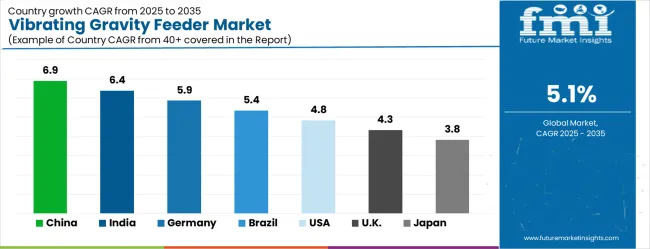
| Country | Market Share (2025) |
|---|---|
| China | 6.9% |
| India | 6.4% |
| Germany | 5.9% |
| Brazil | 5.4% |
| USA | 4.8% |
| UK | 4.3% |
| Japan | 3.8% |
The Vibrating Gravity Feeder market demonstrates varied regional dynamics with Growth Leaders including China (6.9% market share) and India (6.4% market share) driving expansion through manufacturing modernization and industrial automation infrastructure development. Steady Performers encompass Germany (5.9% market share), Brazil (5.4% market share), and the USA (4.8% market share), benefiting from established material handling technology industries and advanced manufacturing automation adoption. Mature Markets feature the UK (4.3% market share) and Japan (3.8% market share), where specialized industrial applications and automation technology integration support consistent growth patterns.
Regional synthesis reveals Asia-Pacific markets leading adoption through manufacturing modernization and industrial automation infrastructure development, while European countries maintain steady expansion supported by material handling technology advancement and manufacturing standardization requirements. North American markets show moderate growth driven by industrial automation applications and feeding system integration trends.
The report covers an in-depth analysis of 40+ countries top-performing countries are highlighted below.
China establishes market leadership through aggressive manufacturing modernization programs and comprehensive industrial automation infrastructure development, integrating advanced vibrating gravity feeders as standard components in food processing facilities and industrial manufacturing installations. The country's 6.9% market share reflects government initiatives promoting industrial automation technology and domestic equipment manufacturing capabilities that mandate the use of advanced feeding systems in manufacturing and food processing facilities. Growth concentrates in major industrial centers, including Shanghai, Guangzhou, and Beijing, where automation technology development showcases integrated feeding systems that appeal to domestic manufacturers seeking advanced material handling capabilities and production efficiency applications.
Chinese equipment manufacturers are developing cost-effective feeding solutions that combine domestic production advantages with advanced control features, including automated dosing systems and enhanced precision capabilities. Distribution channels through industrial equipment suppliers and automation contractors expand market access, while government support for manufacturing automation development supports adoption across diverse food processing and industrial manufacturing segments.
Strategic Market Indicators:
In Mumbai, Delhi, and Chennai, manufacturing facilities and food processing plants are implementing advanced vibrating gravity feeders as standard equipment for production automation and material handling applications, driven by increasing industrial investment and modernization programs that emphasize the importance of precision feeding capabilities. The market holds a 6.4% share, supported by government manufacturing initiatives and industrial infrastructure development programs that promote advanced feeding systems for food processing and manufacturing facilities. Indian manufacturers are adopting feeding systems that provide consistent material handling and automation features, particularly appealing in industrial regions where production efficiency and quality control represent critical operational requirements.
Market expansion benefits from growing industrial equipment manufacturing capabilities and international technology transfer agreements that enable domestic production of advanced feeding systems for food processing and manufacturing applications. Technology adoption follows patterns established in industrial automation, where reliability and precision drive procurement decisions and operational deployment.
Market Intelligence Brief:
Advanced industrial automation market in Germany demonstrates sophisticated vibrating gravity feeder deployment with documented operational effectiveness in manufacturing applications and food processing facilities through integration with existing automation systems and production infrastructure. The country leverages engineering expertise in material handling technology and industrial systems integration to maintain a 5.9% market share. Industrial centers, including Munich, Stuttgart, and Hamburg, showcase premium installations where feeding systems integrate with comprehensive automation platforms and production management systems to optimize material handling and manufacturing effectiveness.
German equipment manufacturers prioritize system reliability and EU compliance in the development of feeding systems, creating demand for premium systems with advanced features, including production monitoring integration and automated control systems. The market benefits from established industrial automation infrastructure and a willingness to invest in advanced material handling technologies that provide long-term operational benefits and compliance with international manufacturing standards.
Market Intelligence Brief:
Market in Brazil expansion benefits from diverse industrial demand, including food processing modernization in São Paulo and Rio de Janeiro, manufacturing facility equipment upgrades, and government industrial programs that increasingly incorporate feeding solutions for production optimization applications. The country maintains a 5.4% market share, driven by rising industrial production and increasing awareness of automation technology benefits, including precise material handling and reduced production waste capabilities.
Market dynamics focus on cost-effective feeding solutions that balance advanced automation features with affordability considerations important to Brazilian manufacturers. Growing industrialization creates sustained demand for modern material handling systems in new manufacturing infrastructure and facility modernization projects.
Strategic Market Considerations:
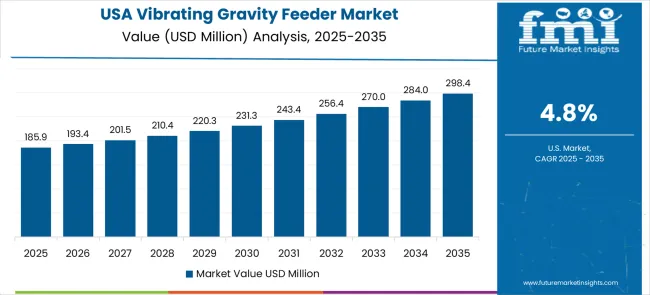
The USA market emphasizes advanced feeding features, including precision material control and integration with comprehensive automation platforms that manage production quality, efficiency optimization, and material handling through unified control systems. The country holds a 4.8% market share, driven by manufacturing modernization and industrial equipment upgrades that support feeding system integration. American manufacturers prioritize operational effectiveness with feeding systems delivering consistent material handling through advanced control algorithms and production adaptation capabilities.
Technology deployment channels include major industrial equipment contractors, specialized material handling suppliers, and manufacturing procurement programs that support professional installation for complex automation applications. Industrial platform integration capabilities with established manufacturing systems expand market appeal across diverse operational requirements seeking precision and reliability benefits.
Performance Metrics:
Japan demonstrates steady market development with a 3.8% market share, distinguished by manufacturing facilities' preference for high-quality feeding systems that integrate seamlessly with existing industrial systems and provide reliable long-term operation in specialized production applications. The market prioritizes advanced features, including precision material control, environmental durability, and integration with comprehensive manufacturing platforms that reflect Japanese industrial expectations for technological sophistication and operational excellence.
In Birmingham, Manchester, and other industrial centers, British manufacturing facilities and food processing plants are implementing advanced feeding systems to enhance production optimization capabilities and support industrial operations that align with manufacturing regulations and quality standards. The UK market holds a 4.3% market share, driven by industrial modernization programs and manufacturing equipment upgrades that emphasize advanced feeding systems for production and processing applications. British manufacturers are prioritizing feeding systems that provide consistent material handling while maintaining compliance with industrial regulations and minimizing production waste, particularly important in industrial operations and manufacturing facilities.
Market expansion benefits from government industrial procurement programs that mandate automation capabilities in manufacturing equipment specifications, creating sustained demand across the UK's manufacturing and food processing sectors, where operational flexibility and precision represent critical requirements. The regulatory framework supports feeding system adoption through industrial equipment standards and compliance requirements that promote advanced material handling systems aligned with production quality management capabilities.
Strategic Market Indicators:
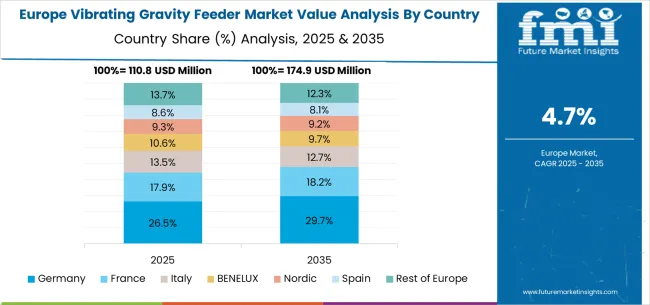
The European Vibrating Gravity Feeder market is projected to grow from USD 98.4 million in 2025 to USD 161.8 million by 2035, registering a CAGR of 5.1% over the forecast period. Germany is expected to maintain its leadership position with a 31.7% market share in 2025, declining slightly to 31.4% by 2035, supported by its advanced industrial automation infrastructure and major manufacturing centers, including Munich and Stuttgart.
France follows with a 24.8% share in 2025, projected to reach 25.2% by 2035, driven by comprehensive manufacturing modernization programs and industrial technology development initiatives. The United Kingdom holds an 18.4% share in 2025, expected to maintain 18.1% by 2035 through specialized industrial applications and EU compliance requirements. Italy commands a 13.6% share, while Spain accounts for 9.1% in 2025. The Rest of Europe region is anticipated to gain momentum, expanding its collective share from 7.4% to 7.8% by 2035, attributed to increasing industrial automation adoption in Nordic countries and emerging Eastern European manufacturing facilities implementing modernization programs.
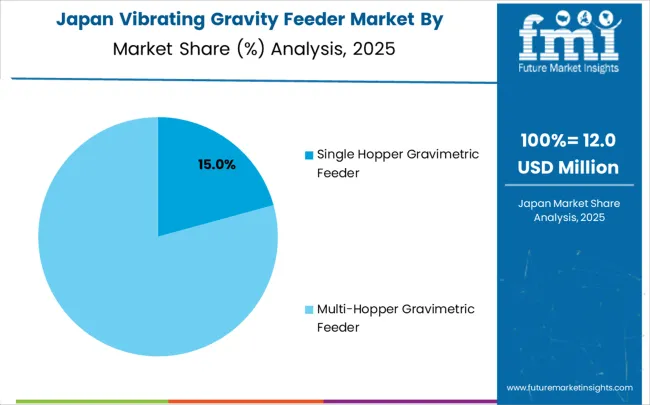
In Japan, the Vibrating Gravity Feeder market prioritizes multi-hopper gravimetric systems, which capture the dominant share of manufacturing and food processing installations due to their advanced features, including precision multi-material handling optimization and seamless integration with existing industrial automation infrastructure. Japanese manufacturers emphasize efficiency, reliability, and precision control, creating demand for multi-hopper systems that provide comprehensive material handling capabilities and adaptive feeding performance based on production requirements and material characteristics. Single-hopper systems maintain secondary positions primarily in specialized applications and small-scale installations where focused material handling functionality meets operational requirements without multi-material complexity.
Market Characteristics:
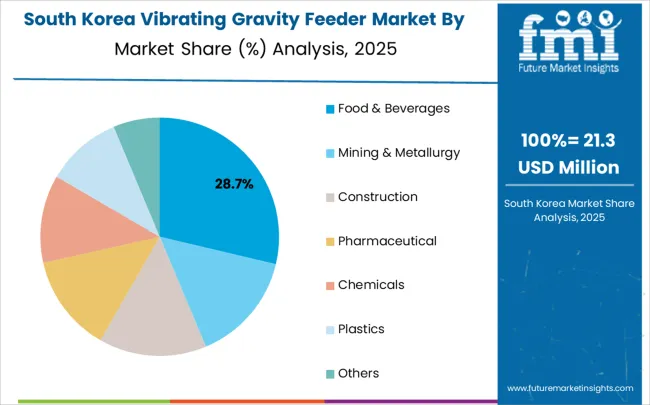
In South Korea, the market structure favors international equipment companies, including Coperion K-Tron, FLSmidth, and Schenck Process, which maintain dominant positions through comprehensive product portfolios and established industrial networks supporting both manufacturing and food processing installations. These providers offer integrated solutions combining advanced feeding systems with professional installation services and ongoing technical support that appeal to Korean manufacturers seeking reliable industrial automation systems. Local industrial contractors and system integrators capture moderate market share by providing localized service capabilities and competitive pricing for standard manufacturing installations. At the same time, domestic manufacturers focus on specialized applications and cost-effective solutions tailored for Korean industrial characteristics.
Channel Insights:
The market operates with moderate concentration, featuring approximately 20-25 meaningful participants, where leading companies control roughly 40-45% of the global market share through established industrial relationships and comprehensive equipment portfolios. Competition emphasizes advanced feeding precision capabilities, system reliability, and integration of automation platforms rather than price-based rivalry.
Market Leaders encompass Coperion K-Tron, FLSmidth, and Brabender, which maintain competitive advantages through extensive material handling expertise, global industrial contractor networks, and comprehensive system integration capabilities that create customer switching costs and support premium pricing. These companies leverage decades of experience in industrial equipment and ongoing research investments to develop advanced feeding systems with precision control and automated monitoring features.
Technology Innovators include WAMGROUP, Schenck Process, and Motan-colortronic, which compete through specialized feeding technology focus and innovative control interfaces that appeal to manufacturers seeking advanced precision capabilities and operational flexibility. These companies differentiate themselves through rapid technology development cycles and a specialized focus on industrial applications.
Regional Specialists feature companies like Kubota, Wuxi Lingood, and Acrison, which focus on specific geographic markets and specialized applications, including multi-hopper systems and integrated automation solutions. Market dynamics favor participants that combine reliable hardware with advanced control software, including precision material handling and automatic feeding optimization capabilities. Competitive pressure intensifies as traditional industrial equipment contractors expand into feeding systems. At the same time, specialized automation companies challenge established players with innovative control solutions and cost-effective platforms targeting specific manufacturing segments.
| Item | Value |
|---|---|
| Quantitative Units | USD 437 million |
| Feeder Type | Single Hopper Gravimetric Feeder, Multi-Hopper Gravimetric Feeder |
| Application | Food & Beverages, Mining & Metallurgy, Construction, Pharmaceutical, Chemicals, Plastics, Others |
| Regions Covered | North America, Europe, Asia Pacific, Latin America, Middle East & Africa |
| Countries Covered | China, India, Germany, Brazil, the U.S., the U.K., Japan, and 25+ additional countries |
| Key Companies Profiled | Coperion K-Tron, FLSmidth, Brabender, WAMGROUP, Schenck Process, Motan-colortronic, Kubota, Wuxi Lingood |
| Additional Attributes | Dollar sales by feeder type and application categories, regional adoption trends across North America, Europe, and Asia-Pacific, competitive landscape with equipment manufacturers and industrial suppliers, manufacturer preferences for precision material handling and system reliability, integration with industrial platforms and automation monitoring systems, innovations in vibrating control algorithms and operational durability, and development of multi-hopper solutions with enhanced precision and manufacturing optimization capabilities. |
The global vibrating gravity feeder market is estimated to be valued at USD 437.0 million in 2025.
The market size for the vibrating gravity feeder market is projected to reach USD 718.7 million by 2035.
The vibrating gravity feeder market is expected to grow at a 5.1% CAGR between 2025 and 2035.
The key product types in vibrating gravity feeder market are single hopper gravimetric feeder and multi-hopper gravimetric feeder.
In terms of application, food & beverages segment to command 28.4% share in the vibrating gravity feeder market in 2025.






Our Research Products

The "Full Research Suite" delivers actionable market intel, deep dives on markets or technologies, so clients act faster, cut risk, and unlock growth.

The Leaderboard benchmarks and ranks top vendors, classifying them as Established Leaders, Leading Challengers, or Disruptors & Challengers.

Locates where complements amplify value and substitutes erode it, forecasting net impact by horizon

We deliver granular, decision-grade intel: market sizing, 5-year forecasts, pricing, adoption, usage, revenue, and operational KPIs—plus competitor tracking, regulation, and value chains—across 60 countries broadly.

Spot the shifts before they hit your P&L. We track inflection points, adoption curves, pricing moves, and ecosystem plays to show where demand is heading, why it is changing, and what to do next across high-growth markets and disruptive tech

Real-time reads of user behavior. We track shifting priorities, perceptions of today’s and next-gen services, and provider experience, then pace how fast tech moves from trial to adoption, blending buyer, consumer, and channel inputs with social signals (#WhySwitch, #UX).

Partner with our analyst team to build a custom report designed around your business priorities. From analysing market trends to assessing competitors or crafting bespoke datasets, we tailor insights to your needs.
Supplier Intelligence
Discovery & Profiling
Capacity & Footprint
Performance & Risk
Compliance & Governance
Commercial Readiness
Who Supplies Whom
Scorecards & Shortlists
Playbooks & Docs
Category Intelligence
Definition & Scope
Demand & Use Cases
Cost Drivers
Market Structure
Supply Chain Map
Trade & Policy
Operating Norms
Deliverables
Buyer Intelligence
Account Basics
Spend & Scope
Procurement Model
Vendor Requirements
Terms & Policies
Entry Strategy
Pain Points & Triggers
Outputs
Pricing Analysis
Benchmarks
Trends
Should-Cost
Indexation
Landed Cost
Commercial Terms
Deliverables
Brand Analysis
Positioning & Value Prop
Share & Presence
Customer Evidence
Go-to-Market
Digital & Reputation
Compliance & Trust
KPIs & Gaps
Outputs
Full Research Suite comprises of:
Market outlook & trends analysis
Interviews & case studies
Strategic recommendations
Vendor profiles & capabilities analysis
5-year forecasts
8 regions and 60+ country-level data splits
Market segment data splits
12 months of continuous data updates
DELIVERED AS:
PDF EXCEL ONLINE
Vibrating Screen Market Size and Share Forecast Outlook 2025 to 2035
Vibrating Screen Market Analysis and Opportunity Assessment in India Size and Share Forecast Outlook 2025 to 2035
Vibrating Conveyer Market Size and Share Forecast Outlook 2025 to 2035
Vibrating Feed Conveyors Market
Gravity Conveyor System Market Size and Share Market Forecast and Outlook 2025 to 2035
Gravity Conveyor Market
Specific Gravity Bench Apparatus Market Growth – Trends & Forecast 2018-2027
IV Infusion Gravity Bags Market Size and Share Forecast Outlook 2025 to 2035
Feeder Container Market Size and Share Forecast Outlook 2025 to 2035
Hog Feeder Market Size and Share Forecast Outlook 2025 to 2035
Belt Feeders Market Size and Share Forecast Outlook 2025 to 2035
Weft Feeder Market Trend Analysis Based on Type, Operation, Application, and Region 2025 to 2035
Pump Feeders Market Growth - Trends & Forecast 2025 to 2035
Part Feeder Market
Cattle Feeder Panels Market Size and Share Forecast Outlook 2025 to 2035
Cattle Feeder Market Size and Share Forecast Outlook 2025 to 2035
Chicken Feeder and Drinkers Market Size and Share Forecast Outlook 2025 to 2035
Poultry Feeder Market Size and Share Forecast Outlook 2025 to 2035
Vibratory Feeder Machine Market Size and Share Forecast Outlook 2025 to 2035
Horse Bunk Feeder Market Size and Share Forecast Outlook 2025 to 2035

Thank you!
You will receive an email from our Business Development Manager. Please be sure to check your SPAM/JUNK folder too.
Chat With
MaRIA